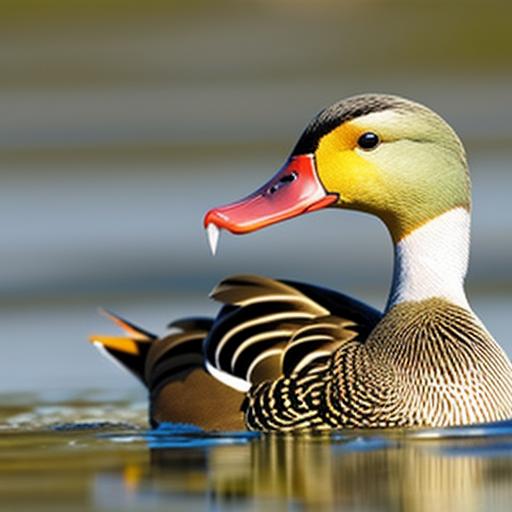Key Takeaways
- Khaki Campbell ducks are a popular breed known for their high egg production and calm temperament.
- When selecting breeding stock, look for healthy, active ducks with good body conformation and strong egg-laying abilities.
- Provide a spacious and secure housing and enclosure for your breeding ducks, with access to water for swimming and foraging.
- A balanced diet with proper nutrition is essential for breeding ducks to ensure optimal egg production and overall health.
- Understanding the breeding cycle, egg laying patterns, and incubation process is crucial for successful Khaki Campbell duck breeding.
Introduction to Khaki Campbell Ducks
The Khaki Campbell duck is a beloved breed that has gained popularity among backyard and small-scale farmers for its exceptional egg-laying abilities, docile temperament, and adaptability to various environments. These ducks, with their distinctive khaki-colored plumage, are not only aesthetically pleasing but also offer a practical and rewarding addition to any poultry flock.
One of the key characteristics that make Khaki Campbell ducks a great choice for beginner duck breeders is their hardy nature. These ducks are known for their resilience, thriving in a wide range of climates and conditions. They are also relatively low-maintenance, making them an excellent option for those new to duck keeping. Additionally, Khaki Campbell ducks are renowned for their impressive egg production, with hens capable of laying up to 300 eggs per year, making them a valuable source of fresh, nutritious eggs for the home or small-scale farm.
Embarking on the journey of breeding Khaki Campbell ducks can be a rewarding and enriching experience for beginners. These ducks are not only visually appealing but also offer a unique opportunity to learn about the intricacies of avian husbandry and the joys of raising a self-sustaining flock. Whether your goal is to establish a thriving backyard flock or to explore the world of small-scale commercial duck farming, the Khaki Campbell duck is a breed that is well-suited to meet your needs.
Selecting the Right Breeding Stock
When it comes to breeding Khaki Campbell ducks, the selection of high-quality breeding stock is crucial. Identifying healthy and genetically diverse individuals is the foundation for a successful breeding program. As a beginner, it is essential to familiarize yourself with the physical characteristics and traits that define the Khaki Campbell breed standard.
Healthy Khaki Campbell ducks should exhibit a robust and well-proportioned body, with a broad, rounded breast and a long, slender neck. The plumage should be a uniform khaki color, with no excessive white or dark feathers. Additionally, the ducks should have clear, bright eyes, a clean bill, and strong, well-developed legs and feet. It is also important to assess the overall temperament of the ducks, as a calm and docile disposition is highly desirable in a breeding flock.
When selecting breeding pairs, it is crucial to consider the genetic diversity of the flock. Inbreeding can lead to a host of health and fertility issues, so it is essential to avoid mating closely related individuals. Instead, seek out unrelated or distantly related ducks to maintain a healthy gene pool. This can be achieved by sourcing breeding stock from reputable breeders or hatcheries that prioritize genetic diversity.
Finding the right sources for Khaki Campbell ducks can be a challenge, but there are several options available to beginner breeders. Connecting with local poultry clubs, attending agricultural fairs, or searching online classifieds can be excellent starting points to locate high-quality Khaki Campbell ducks for your breeding program. Additionally, many hatcheries and specialty duck breeders offer Khaki Campbell ducklings or mature birds for sale, providing a reliable source of breeding stock.
Housing and Enclosure Requirements
Providing the right housing and enclosure for your Khaki Campbell breeding flock is crucial for their health, well-being, and overall productivity. A well-designed duck coop or shelter not only offers protection from the elements but also ensures the ducks have access to the necessary resources to thrive.
When designing the duck coop, it is important to consider the space requirements for your breeding flock. Khaki Campbell ducks require ample room to move around, stretch their wings, and engage in natural behaviors. The coop should be large enough to accommodate the number of ducks you plan to house, with a minimum of 4 square feet of floor space per duck. Additionally, the coop should be well-ventilated to maintain proper air circulation and prevent the buildup of ammonia and other harmful gases.
Adequate access to water is another essential component of the Khaki Campbell duck’s housing. Provide a shallow pool or trough that is deep enough for the ducks to submerge their heads and bodies. This not only allows them to maintain their plumage and regulate their body temperature but also encourages natural preening and bathing behaviors.
Protecting the breeding flock from predators is a critical consideration when setting up the duck enclosure. The coop should be constructed with sturdy materials, such as heavy-gauge wire or hardware cloth, to deter predators. Additionally, the enclosure should be secured with a locking door and positioned in a location that is not easily accessible to potential threats, such as coyotes, foxes, or raccoons.
Incorporating nesting boxes into the duck coop is essential for encouraging egg-laying and providing a safe and comfortable environment for the ducks to lay their eggs. These nesting boxes should be placed in a quiet, secluded area of the coop, with ample bedding material, such as straw or wood shavings, to create a cozy and inviting space for the ducks.
By carefully designing and constructing a suitable housing and enclosure for your Khaki Campbell breeding flock, you can ensure their health, safety, and optimal productivity, laying the foundation for a successful breeding program.
Feeding and Nutrition for Breeding Ducks
| Stage | Activity | Duration |
|---|---|---|
| 1 | Selecting Breeding Stock | 1-2 weeks |
| 2 | Setting Up Breeding Pens | 1 day |
| 3 | Introducing Ducks to Breeding Pens | 1-2 days |
| 4 | Monitoring Egg Production | Ongoing |
| 5 | Collecting and Incubating Eggs | 3-4 weeks |
| 6 | Caring for Ducklings | 8-10 weeks |
Proper nutrition is a critical component of successful Khaki Campbell duck breeding. These ducks have specific dietary requirements that must be met to support their overall health, egg production, and reproductive capabilities.
Khaki Campbell breeding ducks require a balanced diet that is rich in proteins, carbohydrates, and essential vitamins and minerals. A high-quality layer feed, formulated specifically for ducks, is an excellent choice as the foundation of their diet. This feed should provide the necessary nutrients, including calcium for strong eggshells and protein for egg production.
In addition to the layer feed, it is important to supplement the ducks’ diet with additional sources of protein, such as mealworms, chopped boiled eggs, or a commercial duck protein supplement. This extra protein intake helps to support the ducks’ reproductive system and ensures they have the necessary building blocks for producing high-quality eggs.
Access to clean, fresh water is also crucial for Khaki Campbell breeding ducks. Provide a clean, deep water source that allows the ducks to submerge their heads and bodies, as this helps to maintain their plumage and overall health. Additionally, offering a source of grit, such as small stones or crushed oyster shells, can aid in the ducks’ digestion and help them to process their feed more efficiently.
It is important to note that the nutritional requirements of Khaki Campbell ducks may vary depending on their stage of the breeding cycle. During the peak of the breeding season, when egg production is at its highest, the ducks may require a higher protein and calcium intake to support the increased demands on their bodies. Adjusting the feed quantities and composition accordingly can help to ensure the ducks remain healthy and productive throughout the breeding process.
By providing a well-balanced and carefully monitored diet, you can help to ensure the success of your Khaki Campbell duck breeding program, promoting optimal egg production, fertility, and the overall health and well-being of your flock.
Breeding Cycle and Egg Laying
Understanding the Khaki Campbell duck’s breeding cycle is essential for successful egg production and hatching. These ducks typically reach sexual maturity around 6-7 months of age, at which point they will begin to display breeding behaviors and start laying eggs.
The Khaki Campbell breeding cycle is influenced by various factors, including daylight hours, temperature, and the overall health and condition of the ducks. During the peak of the breeding season, which typically occurs in the spring and early summer, the hens will lay eggs at a consistent rate, often producing up to an egg per day.
Monitoring and managing the breeding process is crucial to ensure the ducks are given the best possible conditions for mating and egg production. Providing a spacious and secluded nesting area within the duck coop can encourage the hens to lay their eggs in a safe and comfortable environment. Additionally, observing the ducks’ behaviors, such as courtship displays and mating, can help you to understand the breeding cycle and make any necessary adjustments to the flock’s management.
Factors such as nutrition, housing, and overall flock health can significantly impact the fertility and egg production of Khaki Campbell ducks. Ensuring the ducks have access to a balanced diet, a clean and well-maintained enclosure, and are free from stress or illness can all contribute to higher egg production and better hatching rates.
By closely monitoring the Khaki Campbell breeding cycle and making informed decisions to support the ducks’ reproductive needs, you can maximize the success of your egg production and hatching efforts, ultimately leading to a thriving and self-sustaining flock.
Incubating and Hatching Khaki Campbell Eggs
Once the Khaki Campbell hens have laid their eggs, the next step in the breeding process is to properly incubate and hatch the eggs. This stage requires careful attention and attention to detail to ensure the successful development and emergence of healthy ducklings.
Selecting the right incubator is crucial for the successful incubation of Khaki Campbell eggs. The incubator should be able to maintain the appropriate temperature, humidity, and air circulation levels required for optimal egg development. Carefully following the manufacturer’s instructions and monitoring the incubator’s performance throughout the incubation period is essential to ensure the best possible hatching outcomes.
During the incubation process, it is important to regularly candle the eggs to monitor their development and identify any potential issues. Candling, the process of shining a bright light through the egg, allows you to observe the growth of the embryo and detect any signs of problems, such as lack of development or the presence of cracks or abnormalities.
As the incubation period nears its end, typically around 28 days for Khaki Campbell ducks, it is important to closely monitor the hatching process. Providing a warm, humid environment and avoiding unnecessary disturbances can help the ducklings emerge successfully. In some cases, gentle assistance may be required to help the ducklings break free from their shells, but this should only be done with great care and caution to avoid harming the delicate hatchlings.
By meticulously managing the incubation and hatching process, you can ensure the successful development and emergence of healthy Khaki Campbell ducklings, laying the foundation for the next generation of your breeding flock.
Brooding and Raising Khaki Campbell Ducklings
Once the Khaki Campbell ducklings have hatched, the next critical stage in their development is the brooding and rearing process. Providing the right environment and care for these young ducks is essential for their growth, health, and successful integration into the breeding flock.
The brooding area should be set up with the appropriate temperature, humidity, and ventilation to create a comfortable and safe environment for the ducklings. A well-designed brooder, equipped with a heat lamp or other heating source, can help maintain the optimal temperature range and prevent the ducklings from becoming chilled or overheated.
Feeding and watering the young ducklings is a crucial aspect of their care. Providing a high-quality starter feed, formulated specifically for ducklings, can ensure they receive the necessary nutrients for growth and development. Additionally, offering a clean, shallow water source that is easily accessible to the ducklings is essential for their hydration and overall health.
As the ducklings grow and mature, it is important to gradually introduce them to the outdoor enclosure and the rest of the breeding flock. This process of socialization and imprinting helps the ducklings become accustomed to their new environment and develop a strong bond with their flock mates. Careful monitoring during this transition period can help ensure a smooth and successful integration.
By dedicating time and attention to the brooding and rearing of Khaki Campbell ducklings, you can help ensure their healthy development and set the stage for their successful integration into the breeding flock. This, in turn, will contribute to the long-term success and sustainability of your Khaki Campbell duck breeding program.
Health and Disease Management
Maintaining the health and well-being of your Khaki Campbell breeding flock is crucial for the success of your duck breeding program. Understanding common health issues and implementing effective disease management strategies can help prevent and address any potential problems that may arise.
Khaki Campbell ducks, like all poultry, are susceptible to a range of health conditions, including respiratory infections, parasitic infestations, and digestive issues. Recognizing the early signs of illness, such as lethargy, decreased appetite, or changes in the appearance of the feathers or droppings, can help you take prompt action to address the problem.
Preventive measures, such as regular vaccination and implementing strict biosecurity protocols, can play a significant role in maintaining the overall health of your Khaki Campbell breeding flock. Consulting with a veterinarian who specializes in avian medicine can help you develop a comprehensive health management plan tailored to the specific needs of your flock.
In the event that a health issue does arise, it is essential to seek veterinary care promptly. A qualified veterinarian can provide an accurate diagnosis and recommend the appropriate treatment, whether it’s medication, dietary adjustments, or other interventions. Addressing health concerns in a timely manner can help prevent the spread of disease within the flock and ensure the continued well-being of your Khaki Campbell ducks.
By prioritizing the health and disease management of your Khaki Campbell breeding flock, you can minimize the risk of setbacks and ensure the long-term success and sustainability of your duck breeding program.
Tips for Successful Khaki Campbell Duck Breeding
Embarking on the journey of Khaki Campbell duck breeding can be a rewarding and fulfilling experience, but it also requires a commitment to continuous learning and improvement. By incorporating the following tips, you can enhance the success of your breeding program and become a more confident and effective Khaki Campbell duck breeder.
Maintaining detailed records and breeding logs is a crucial aspect of successful duck breeding. Keeping track of important information, such as the breeding pairs, egg production, hatch rates, and the overall health and performance of the flock, can help you identify patterns, make informed decisions, and continuously refine your breeding practices.
Networking with other Khaki Campbell duck breeders, whether through online forums, local poultry clubs, or industry events, can be an invaluable resource. Sharing knowledge, experiences, and best practices can help you overcome challenges, stay up-to-date with the latest developments in the field, and connect with potential sources of breeding stock or mentorship.
Continuously improving your breeding practices and genetics is essential for the long-term success of your Khaki Campbell duck breeding program. This may involve selectively breeding for desirable traits, introducing new genetic diversity to the flock, and closely monitoring the health and performance of your ducks to identify areas for improvement.
Lastly, be prepared to adapt and troubleshoot as challenges arise. Duck breeding, like any agricultural endeavor, can present unexpected obstacles, from environmental factors to health issues. Approaching these challenges with a problem-solving mindset, a willingness to learn, and a commitment to the well-being of your flock can help you navigate these hurdles and ensure the ongoing success of your Khaki Campbell duck breeding program.
By incorporating these tips and continuously striving to enhance your knowledge and skills, you can become a confident and successful Khaki Campbell duck breeder, contributing to the preservation and advancement of this remarkable breed.
FAQs
What are Khaki Campbell ducks?
Khaki Campbell ducks are a domestic breed of duck that is known for its high egg production. They are a cross between the Indian Runner, Rouen, and Mallard duck breeds.
What is the purpose of breeding Khaki Campbell ducks?
Breeding Khaki Campbell ducks is primarily done for their high egg production. They are also popular for their calm temperament and adaptability to various climates.
What are the basic requirements for breeding Khaki Campbell ducks?
Basic requirements for breeding Khaki Campbell ducks include a suitable living environment with access to water for swimming, a balanced diet of commercial duck feed and fresh water, and proper nesting areas for egg laying.
What is the breeding process for Khaki Campbell ducks?
The breeding process for Khaki Campbell ducks involves selecting healthy breeding stock, providing proper nutrition and care, ensuring suitable living conditions, and allowing natural mating to occur.
How long does it take for Khaki Campbell ducks to start laying eggs?
Khaki Campbell ducks typically start laying eggs at around 20-24 weeks of age, although this can vary depending on individual ducks and environmental factors.
What are some common health issues to watch out for when breeding Khaki Campbell ducks?
Common health issues to watch out for when breeding Khaki Campbell ducks include respiratory infections, bumblefoot, and egg binding. It is important to provide proper veterinary care and maintain a clean living environment to prevent these issues.
Meet Walter, the feathered-friend fanatic of Florida! Nestled in the sunshine state, Walter struts through life with his feathered companions, clucking his way to happiness. With a coop that’s fancier than a five-star hotel, he’s the Don Juan of the chicken world. When he’s not teaching his hens to do the cha-cha, you’ll find him in a heated debate with his prized rooster, Sir Clucks-a-Lot. Walter’s poultry passion is no yolk; he’s the sunny-side-up guy you never knew you needed in your flock of friends!








